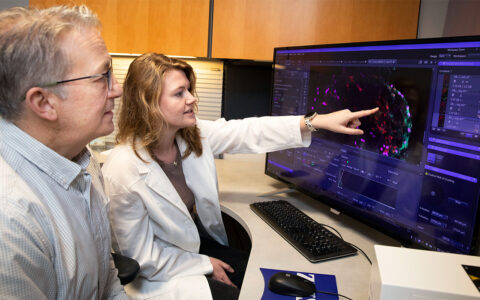Teprotumumab, marketed under the brand name Tepezza, was developed to offer patients with thyroid eye disease (TED) a treatment for the disabling and sometimes disfiguring condition.
TED, also sometimes called Graves’ orbitopathy, is associated with eye symptoms including proptosis, edema and diplopia, and has been under-addressed by previous treatments.
“This is the first treatment of any kind that makes the eye muscles — which become enlarged in so many thyroid eye disease patients — go back to normal size and function,” said Louise Mawn, M.D., oculoplastics division chief at the Vanderbilt Eye Institute. “You can actually turn back the clock and put the person’s anatomy and function back to its pre-disease state.”
This relatively new treatment involves eight intravenous infusions of teprotumumab, a monoclonal antibody that inhibits the insulin-like growth factor 1 receptor (IGF-1R). The treatment was approved in the U.S. in early 2020 following successful phase 2 and 3 randomized trials.
Since its approval, Mawn, an expert on orbital diseases, has been using the novel agent to treat patients with TED and has established clinical protocols for managing treatment.
“I think of thyroid eye disease as a very close cousin to Graves’ disease,” Mawn said. “Although it is associated with the underlying autoimmune disease of the gland, it is its own distinct entity that needs to be treated.” Patients with primary Graves’ disease are at higher risk of developing TED, which affects the muscle and fat tissue behind and around the eye.
A Complex Hormonal Connection
The pathophysiology of TED involves complex interactions between IGF-1R and thyroid stimulating hormone receptor (TSHR), lymphocytes and cytokines. This interplay leads to the activation of orbital fibroblasts responsible for the characteristic soft tissue changes of TED that can lead to disfigurement or disability.
“Insulin-like growth factor 1 is coupled to thyroid stimulating hormone receptor,” explains Mawn. “By down-regulating the insulin-like growth factor 1 receptor, we can extinguish the fire of the thyroid eye disease-related changes and inflammation.”
Pros and Cons of Treatment
Once patients are approved for teprotumumab treatment, they receive an infusion of the biologic every three weeks, for a total of eight infusions over the course of 24 weeks.
Documented adverse side effects have included exacerbation of inflammatory bowel disease symptoms. It may also be associated with hyperglycemia and hearing impairment, as well as changes to taste and smell.
“Those are all side effects or complications that we look for closely to make sure they are not realized,” Mawn said. Minor side effects may include fatigue or muscle spasms.
Vanderbilt’s existing infrastructure includes home health-care nursing capabilities and relationships with insurance providers offering patients a more streamlined and complete level of service.
Before the availability of teprotumumab, patients with TED often possessed lifelong visual limitations, as well as changes to their eye tissue. “We’re happy we now have a treatment that can significantly improve quality of life,” Mawn said.
Ongoing TED Support
Vanderbilt Eye Institute gives patients wraparound service, from testing to treatment, mitigation of side effects, and advanced care, according to Mawn.
“One of the really unique aspects of Vanderbilt’s treatment of patients with orbital disease – including thyroid eye disease – is our ability to handle all these very complex, very challenging patients in a multidisciplinary setting.”




